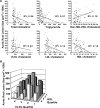VLDL best predicts aortic root atherosclerosis in LDL receptor deficient mice
- PMID: 18957695
- PMCID: PMC2638101
- DOI: 10.1194/jlr.M800284-JLR200
VLDL best predicts aortic root atherosclerosis in LDL receptor deficient mice
Abstract
Hyperlipidemia is a major risk factor for developing atherosclerosis in humans, and epidemiological studies have correlated specific lipoprotein levels with cardiovascular disease risk. Murine models of atherosclerosis rely on the induction of hyperlipidemia for vascular lesions to form, but the pathogenic contributions attributed to different lipoprotein populations are not well defined. To address this issue, we analyzed over 300 LDL receptor (LDLR) deficient mice that have been fed a high-fat diet and for which a full lipoprotein profile and aortic root atherosclerosis values were assessed. Overall, aortic root atherosclerosis is best predicted by plasma VLDL cholesterol levels with less predictive value derived from either LDL or HDL cholesterol. Triglyceride levels are more atherogenic in female mice, especially immune competent females, and depletion of the adaptive immune system leads to a global reduction in plasma lipid levels and aortic root lesion size yet does not appear to alter the atherogenic potential of individual lipoprotein subspecies. In contrast, HDL-cholesterol is a better predictor of aortic root atherosclerosis in apoE-deficient mice. In summary, this large scale analysis of high-fat diet fed LDLR deficient mice highlight the relationship between different plasma lipid components, especially VLDL-cholesterol, and aortic root atherosclerosis.
Figures






References
-
- Hansson G. K., A. K. Robertson, and C. Söderberg-Nauclér. 2006. Inflammation and atherosclerosis. Annu Rev Pathol. 1 297–329. - PubMed
-
- Getz G. S., P. A. VanderLaan, and C. A. Reardon. 2007. The immune system and murine atherosclerosis. Curr. Drug Targets. 8 1297–1306. - PubMed
-
- Hansson G. K. 2005. Inflammation, atherosclerosis, and coronary artery disease. N. Engl. J. Med. 352 1685–1695. - PubMed
-
- Sharrett A. R., C. M. Ballantyne, S. A. Coady, G. Heiss, P. D. Sorlie, D. Catellier, and W. Patsch, and the Atherosclerosis Risk in Communities Study Group. 2001. Coronary heart disease prediction from lipoprotein cholesterol levels, triglycerides, lipoprotein(a), apolipoproteins A-I and B, and HDL density subfractions: The Atherosclerosis Risk in Communities (ARIC) Study. Circulation. 104 1108–1113. - PubMed
-
- National Cholesterol Education Program (NCEP) Expert Panel on Detection, Evaluation, and Treatment of High Blood Cholesterol in Adults (Adult Treatment Panel III). 2002. Circulation. 106: 3143–3421. - PubMed
Publication types
MeSH terms
Substances
Grants and funding
LinkOut - more resources
Full Text Sources
Medical
Molecular Biology Databases
Miscellaneous

